by Editor | Feb 18, 2019 | Attractions, Luxury Travel
By Elena del Valle
Photos by Gary Cox
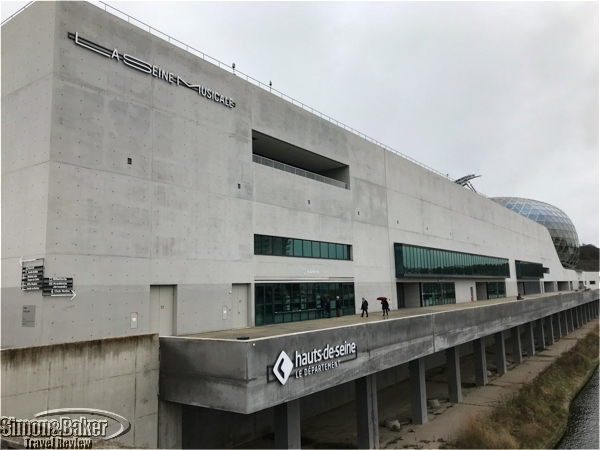
La Seine Musical
On our most recent trip to Paris, France we discovered La Seine Musicale (Ile Seguin, 92 Boulogne-Billancourt, France, www.laseinemusicale.com, + 33 1 74 34 53 53), an events venue opened in 2017 on the outskirts of the city.

The venue is on an island in the center of the Seine River just outside Paris.
The building, situated on the Seguin Island, has a distinctive architectural design. Inside natural lit filtered past wood and glass walls, drawing us our gaze across the river. The high ceiling gave the building a sense of space.
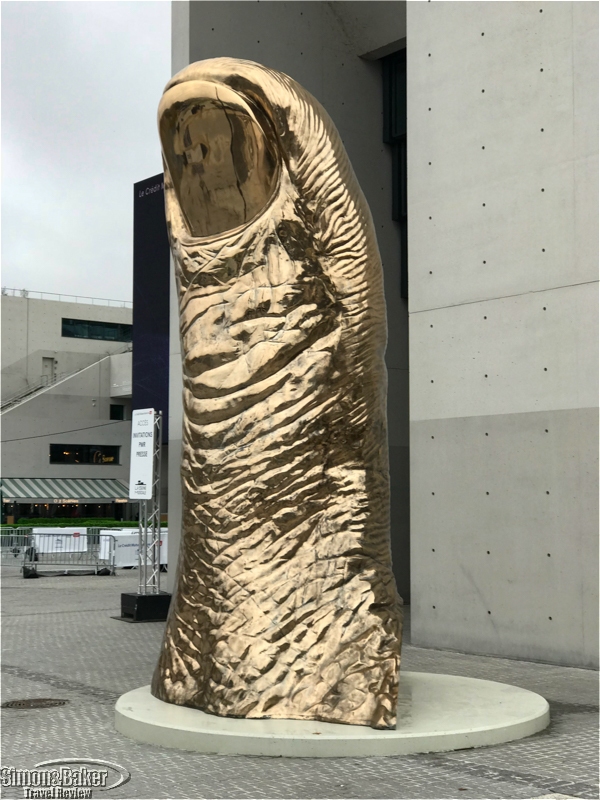
There was a huge sculpture of a thumb in front of the building.
We attended a one hour and fifty minute guitar performance by Liat Cohen accompanied by tenors Rolando Villazon and Charles Castronovo, soprano Sandrine Piau and the Orchestre Pasdeloup. They performed works by Joaquin Rodrigo, Enrique Granados, Jules Massenet, Gabriel Faure, Francisco Tarrega, Isaa Albeniz, Manuel de Falla, Fernando Sor, Tomas Barreras, Rafael Calleja and Tomas Breton. They were fresh from recording Paris-Madrid, an album, that year. It was available for purchase outside the concert hall. Liat’s guitar playing was excellent, earning her repeated applause. It was my favorite part of the show.
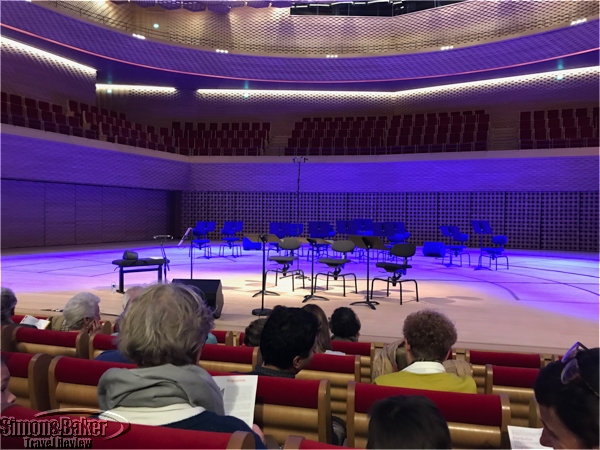
The stage minutes before the start of the performance.
According to her biography Cohen earned First Prize at the Paris Conservatory, graduated from the Schola Cantorum and the École Normale de Musique de Paris; and was the first guitarist to have received the Nadia Boulanger Prize from the Foundation of France.
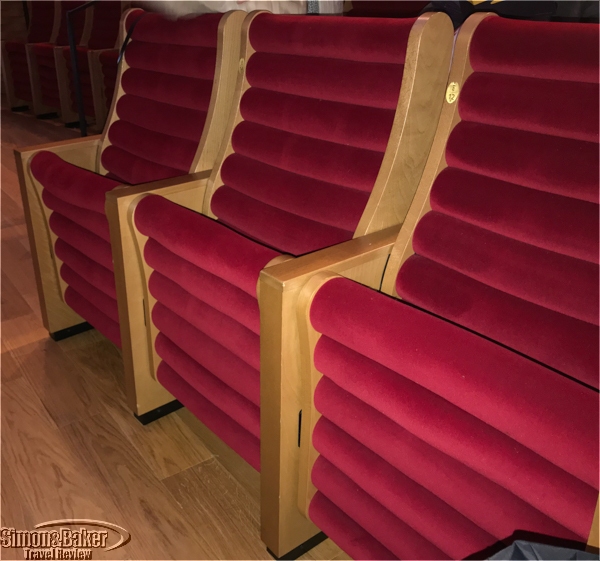
The seats were comfortable and solid.
Our seats (Category 1, E8-10) were comfortable and the view to the stage was unobstructed. Due to photography restrictions we were unable to take photos once the musicians began playing and singing.

The backs and arms of the seats were blonde wood.
I had read in advance about La Seine Musicale’s rooftop garden, but despite several attempts on arrival and departure it was impossible to visit the garden. Once inside the staff said we couldn’t reach the garden and weren’t allowed to exit and re-enter. At the conclusion of the afternoon show the staff member I spoke with indicated the roof garden was closed.
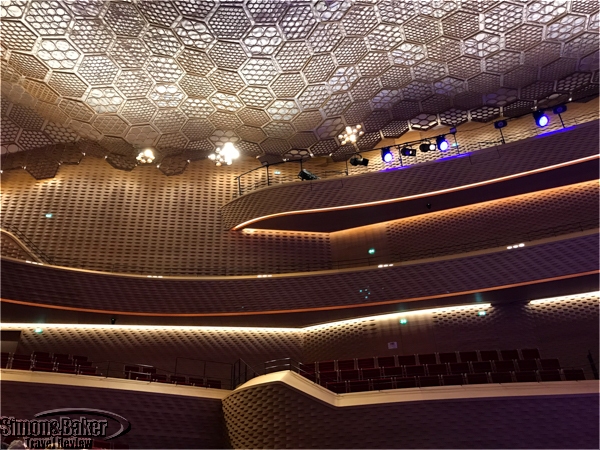
The walls and ceiling of the theater were covered with a variety of textures and materials.
The theater had two halls with a maximum capacity of 6,000 during 150 shows and an approximate annual attendance of 350,000. The name was derived from the River Seine and the French name for stage, Scène. It was a public private partnership owned by STS Evenements, a joint venture between TF1 and Sodexo.
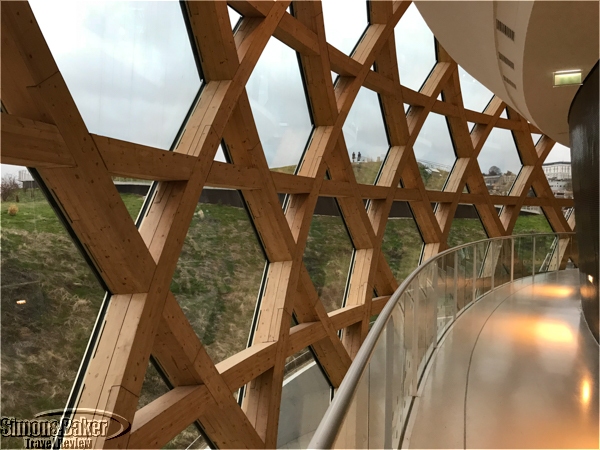
The interior of the dome looking out through solid wood supports
The greatest challenge was that from the Left Bank in central Paris it took us about one hour to reach La Seine Musicale. For a worthwhile performance I would attend a concert there again and recommend it to friends.
by Editor | Jan 22, 2019 | Attractions, Luxury Travel, Products
By Elena del Valle
Photos by Gary Cox and Elena del Valle*

The exterior of the Maison Tournaire shop steps away from the famous place Vendome
It was a chilly and clouded Friday afternoon when I arrived at Maison Tournaire (7 place Vendôme, Paris, France, +33 4 77960884, www.philippetournaire.com, mathieu.pallay@philippetournaire.com), a stone’s throw from the famous Place Vendome in Paris, France for a small group half-day workshop in French. Perhaps because of the well-known venue and crowded streets it was the kind of activity I suspect most tourists never know exists. It had been raining on and off all day. Despite rushing I was five or ten minutes late. As soon as I entered the boutique the staff made me at ease, explaining the workshop had yet to start. While I was still near the door another attendee arrived, distressed at being late. She had been circling the area in search of a parking place for a long while, she explained, making me feel better about my own tardiness.
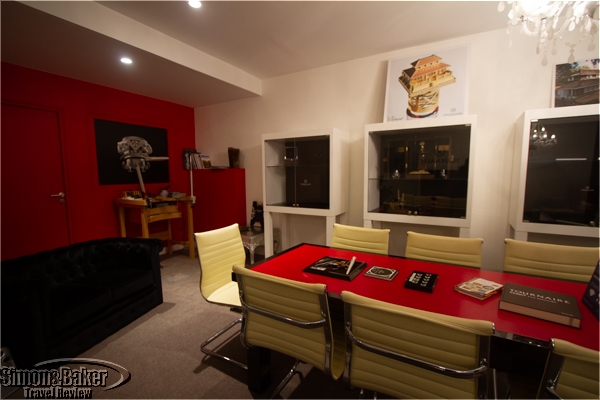
The meeting room where the workshop took place
The interior of the shop was well lit and populated with jewel filled glass cases. It was elegant without being intimidating, adult yet youthful. Marie, one of the two staff members, put away our wet raincoats and umbrellas, offering us welcome hot beverages in exchange.
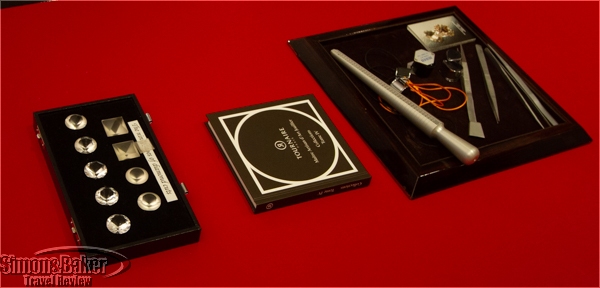
Some of the tools and materials we used during the workshop
After greetings from our host Mathieu Tournaire we climbed one floor upstairs where we sat at a conference table. Mathieu and I had an opportunity to chat earlier that day when he explained everything the company makes is Tournaire-ized. “We don’t just make jewelry, we tell stories,” he told me with a serious expression in between private appointments with clients. The clean shaven jeweler had a quiet confidence that bellied his youthful appearance and the easy manner of a salesman.
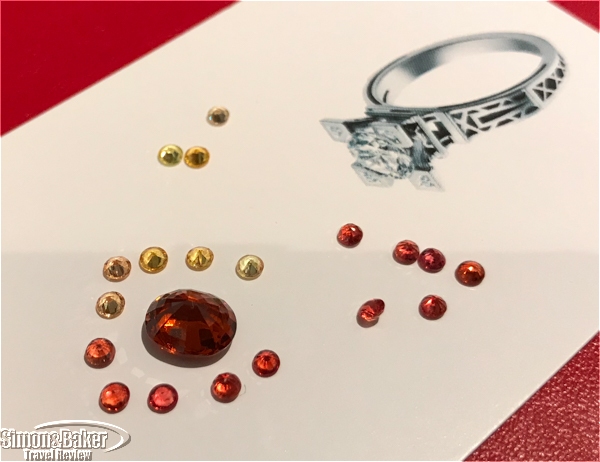
We initially discussed a ring design that could include my yellow and orange sapphires and possibly a large house stone.
Some 15 percent of Tournaire sales were custom orders, he explained. He and his father, Philippe Tournaire, were the creative engines of the firm and both lived outside of Paris. In addition to the Paris location there were stores in Lyon (4 rue Childebert) and Savigneux (2 rue des métiers), where they lived. Whenever he was in town his calendar was full of client appointments.
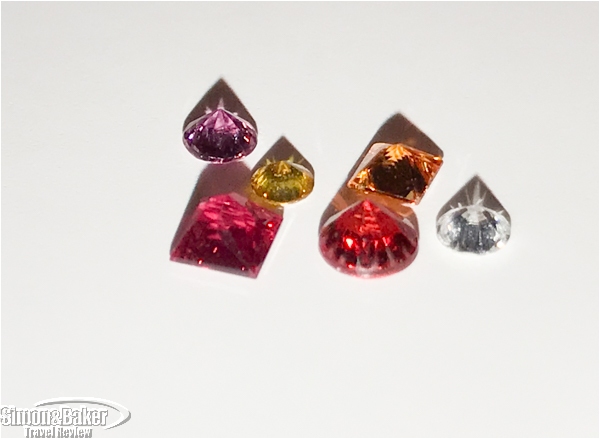
Stones Mathieu selected for the ring
More than half of the attendees had cancelled their workshop reservations because of the soggy weather or the ongoing Yellow Vest demonstrations that riddled France for weeks and peaked on weekends so in lieu of the original nine we were only four. The small group and easy manner of the other attendees made the workshop intimate, allowing each of us to hold tools, rough stones and gemstones in our hands, and observe them with loopes.
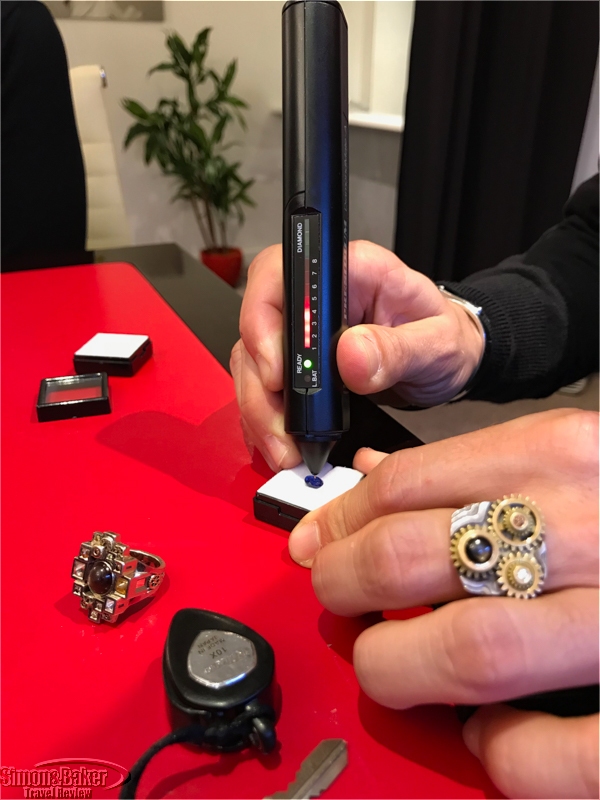
Mathieu demonstrated the use of a device to test diamonds
Mathieu held up a tablet to show us photos, discussing weights, measures, gemstone classifications, varieties and hardness, diamond colors, cuts and facets and demonstrated how to test a diamond with an electronic device. He explained that in France only diamonds, emeralds and sapphires (including rubies) are precious stones. He also discussed opals and star sapphires in passing. Time flew and before I realized it the workshop had ended. At its conclusion we each received a stamped certificate or Certificat de Participation as a souvenir.
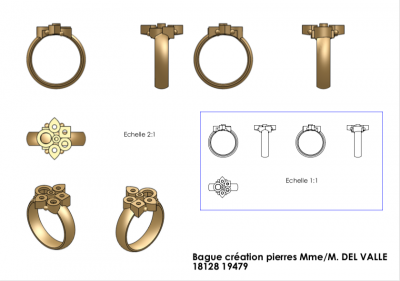
An image of the 3D model for the ring Mathieu designed (*courtesy of Maison Tournaire)
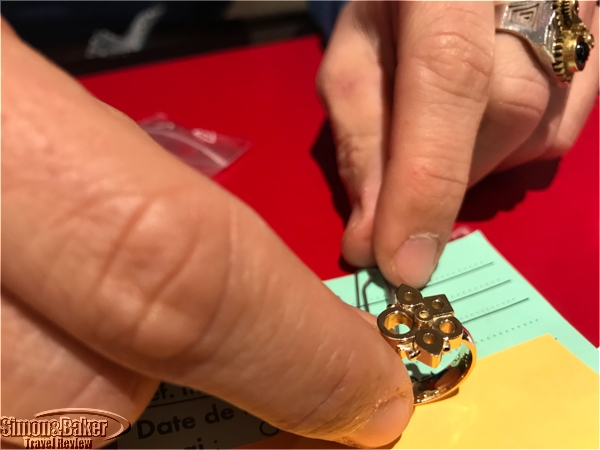
The ring setting Mathieu designed without stones, just the yellow gold part
Once the workshop was over Mathieu spent private time with several of the attendees. Earlier in the day he and I had discussed an idea for a custom made ring. He had drawn a Tournaire-ized concept on a piece of paper and shown me some small gemstones for possible inclusion (diplomatically rejecting my own stones). If all went well, he would share a 3D design via email before making a ring to show me before I left France.
Outside it was dark, but at least the rain had slowed to a drizzle. I didn’t mind the rush hour crowds and wet pavement so much as I walked back to the rue de Rivoli and south toward the Left Bank remembering my fun afternoon.
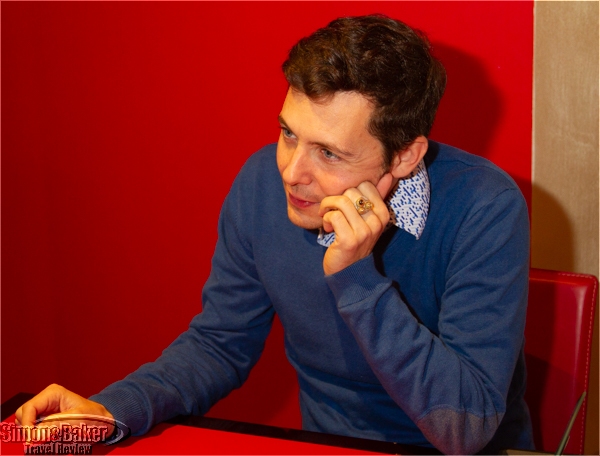
Mathieu Tournaire, artistic director, Maison Tournaire
Maison Tournaire was founded by Philippe Tournaire, a self taught jeweler, in 1973. Mathieu, the artistic director, joined the team in 2008. Maison Tournaire creations were designed to be easily recognized. I had an opportunity to see several of the lines and try on some of the pieces at the shop such as Engrenage (Mathieu wore a distinctive ring of that line), Alchimie, Pensée Sauvage, French Kiss, and Architecture. The ring he created reminded me of the Marélie line, a favorite along with French Kiss.
I liked that Tournaire products were made 100 percent in-house and in France. I appreciated the warm authentic service and efficient follow through. Where attendants at other shops I visited in the place Vendome area were solicitous their welcome was superficial, their demeanor stiff and cool. For example, an eager saleslady on the rue de la Paix offered tax free processing, but could not answer simple questions about the treatment or provenance of her gemstones. Mathieu answered my queries quickly and candidly. One overly inquisitive vendor at a nearby luxury boutique promised to email me information about items they expected to receive, but I never heard from him. In contrast Mathieu and his staff were helpful and responsive without ever being pushy. After the workshop he followed up promptly with the drawing and 3D design we had discussed. Likewise Marie was in touch promptly to schedule a new appointment.
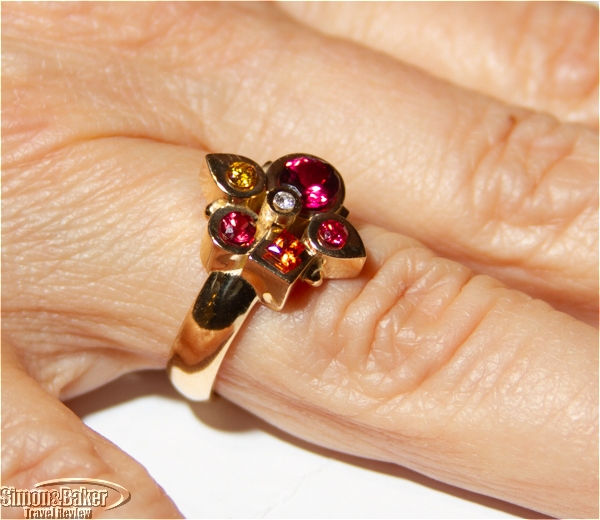
The stones resting on the setting allowed us to see how the finished ring might look.
Two weeks later when Mathieu returned to Paris he brought a 12 by 15 millimeter 18 karat yellow gold ring to show me. It weighed 8 grams and was priced at 3,900 euros. The stones he selected were: 5 millimeter tourmaline rubellite (a red tourmaline), 3 millimeter round red sapphire, 3 square millimeter orange sapphire, two color diamonds of 0.06 carats each, and a white 0.04 diamond. The ring was unfinished, but by placing the gems in their settings it was easy to imagine what it would look like. I especially liked that the diamonds were slightly elevated to protect the other stones. As the hardest stones diamonds would take the brunt of any impact if the wearer banged the ring by accident.
The ring was temptingly pretty. It reminded me of a friend’s redesigned and repurposed wedding ring after her divorce. Every time she looked at it her eyes sparkled with delight. Despite my interest by then my budget had already been fully allocated. Who knows, the next time I am in Paris and have a milestone to celebrate I might pop into Tournaire and say hello. I wouldn’t hesitate to recommend the workshop to friends with an interest in French jewelry wanting an off the beaten track experience in Paris. I would also recommend the shop to those in the market for the brand’s distinctive style.
by Editor | Jan 2, 2019 | Luxury Travel
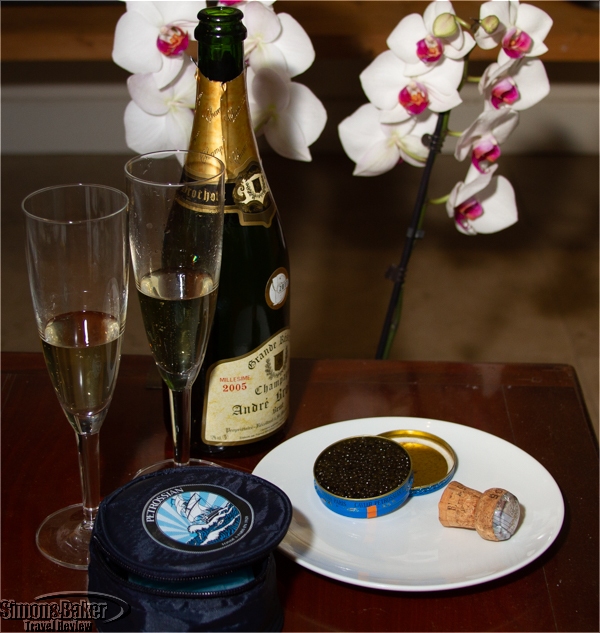
Best wishes for a prosperous New Year!
by Editor | Jul 23, 2018 | Luxury Travel
Article by Scott S. Smith
Photos by Gary Cox
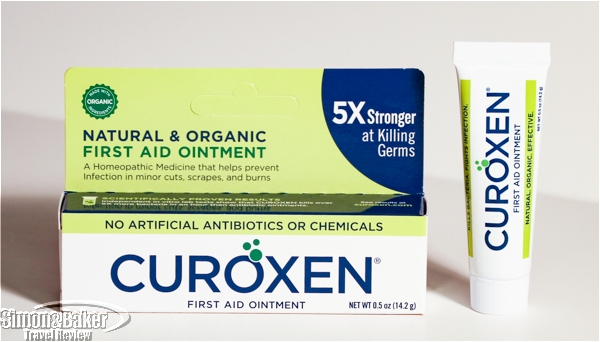
Curoxen was made by an Italian homeopathic medicine company, according to the manufacturer’s website.
A couple of days after receiving a half-ounce tube of Curoxen: First Aid Ointment in the mail, I accidentally cut myself. The ointment soothed the cut immediately. My skin seemed to heal so fast I wasn’t even sure exactly when it happened, perhaps faster than my standard antibiotic ointment. A week later, I couldn’t even remember exactly where the cut had been. I would take Curoxen First Aid with me on my next trip, rather than my usual ointment.
The Curoxen tube said it uses a natural approach as an alternative to conventional treatments to prevent infection, heal and reduce pain for minor wounds, burns, cuts, and scrapes while relying on homeopathy, a European philosophy of “likes cures like” developed in the 18th century. I agree, as the box notes, that “overuse of antibiotics is a global problem.”
According to the company website, Curoxen is available over-the-counter at pharmacies. The half-ounce tube retailed for $9.99 and the one ounce size for $14.99. The active ingredients, per the package were olive extract “2X HPUS and calendula 3X HPUS.” This refers to the standards of the Homeopathic Pharmacopoeia of the United States. Homeopathy uses minute amounts of organic substances, which homeopathic doctors believe help specific problems. The 2X and 3X indicate the number of times the ingredient was diluted in the process of making it, so that there is one percent of the olive extract and just one-tenth of a percent of the calendula. The inactive ingredients were oxygenated olive oil and pure essential oil of lavender. The box indicated there were no petroleum products or preservatives.
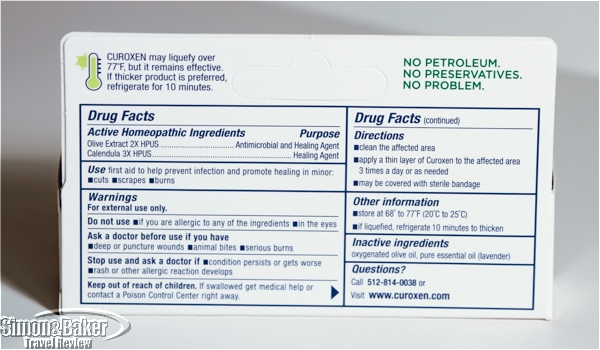
The back of the package listed the active homeopathic ingredients and other important information.
According to the website of Curoxen’s parent company OrganiCare (2101 E. St. Elmo Road, Austin Texas 78744, +1 512-401-3572, www.curoxen.com, info@organicare.com), independent in vitro lab tests show that this product “kills over five times more bacteria than antibiotic ointments.” The formula was based on an Italian university discovery of the healing benefits of olive oil when combined with oxygen. Curoxen was manufactured by an Italian homeopathic medicine company, according to the website (I could not find the country of manufacture on the package).
Per her bio, Caroline Goodner, chief executive officer, OrganiCare, founded two genetics companies and was chief executive of a firm specializing in wellness products for new moms. David Shockley, chairman, was described as a biologist focused on innovation in medical devices. Eleanor Piel Womack, M.D. was listed as board certified in internal medicine and anti-aging and regenerative medicine and the company’s medical advisor on the Curoxen website.
Having worked with integrative doctors, who relied on conventional and unorthodox medicine, I have heard of many patients claims to be helped by homeopathy. Also, I have heard anecdotes from pilots who swore by the formula for jet lag, and people who massaged painful legs with an ointment they claimed worked better than anything else. While I don’t believe the effectiveness of homeopathy has been proven in humans, it’s hard for me to dismiss my experience with this ointment as purely psychosomatic.
by Editor | Jan 22, 2018 | Luxury Travel, Products
Article and photos by Gary Cox
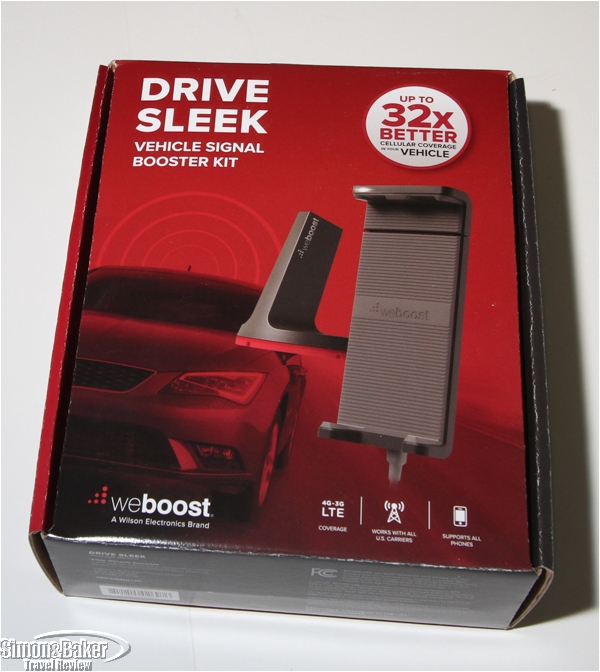
The weboost Drive Sleek Vehicle Signal Booster Kit
Cellular reception in Palm Beach County, Florida for our carrier varies from great to non-existent as we drive around during the course of a weekend, running errands and visiting the beach. Dropped calls are common, and there are places where the signal is so weak that a call cannot be completed. That was why we took advantage of the opportunity to try out the new Drive Sleek Vehicle Signal Booster Kit from weBoost (3301 E. Deseret Drive, St. George, Utah 84790, +1-866-294-1660, https://weboost.com, support@weboost.com). The .55 pound device was designed and assembled in the United States with foreign parts, according to the box.

The box contained a detailed manual and a number to call for help.
Our kit contained an antenna with a magnetic base, a signal booster, a 12 volt power plug, a cradle for the phone and the cables to connect them together. The parts were labeled with numbered stickers that designated the installation procedure. I placed the antenna on the rear deck of our mustang convertible and ran the cord into the trunk. The booster’s Velcro like attachment and some cable wraps made it simple for me to affix it to the lining in the trunk behind the backseat. I was able to fit the cables up and around the seat, tucked out of the way for the most part, except for the jump to the center console where the power plug resides.
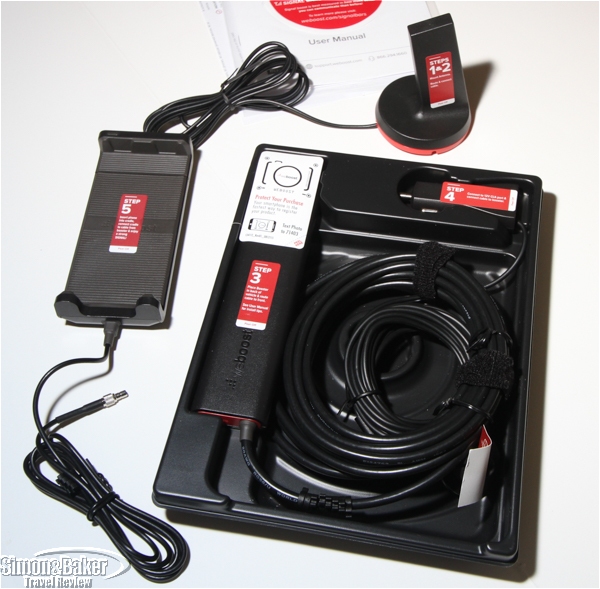
The components had numbered stickers showing the installation order.
The cradle came with an attachment to fit the vents on some cars, but was just not practical in the vents on the mustang. The vent mounting (a little split cone with a magnetic back) helped keep the cradle from sliding off the center console. The cone on the back of the cradle fit into a cup holder and stayed put under normal driving conditions. The power plug must be disconnected when not in use as it continues to draw power even without the car running. A light on the cradle indicates that it is powered up. I prefer to unplug it rather than risk that in a rush I might leave it hooked up and return to a dead battery. It is not clear how long it would take to run the battery down.
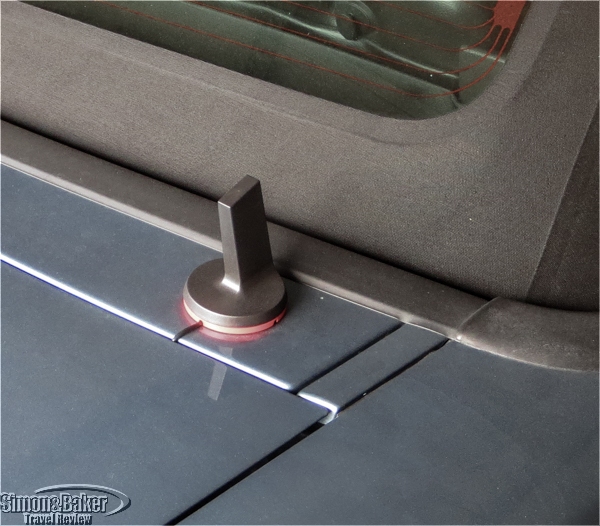
The magnetic antenna mount held securely between the trunk and the soft top
As soon as I placed a phone in the cradle, the effect of the booster was visible in the number of signal bars on the display. A hands free, either Bluetooth or wired is necessary for comfort and according to the user manual. The Federal Communications Commission (F.C.C.) requires that users never hold the device in the cradle up to their ears. Some local municipalities require the use of a hands free headset from drivings using a mobile phone. Our iPhone has the hands free jack on the top, so it had to be inserted into the cradle upside down. Once there it then remained in the spring loaded slot. After several trials with the new configuration, we managed to maintain calls while driving across the county without any drops or loss of signal, and the mobile phone worked in what previously were dead zones.
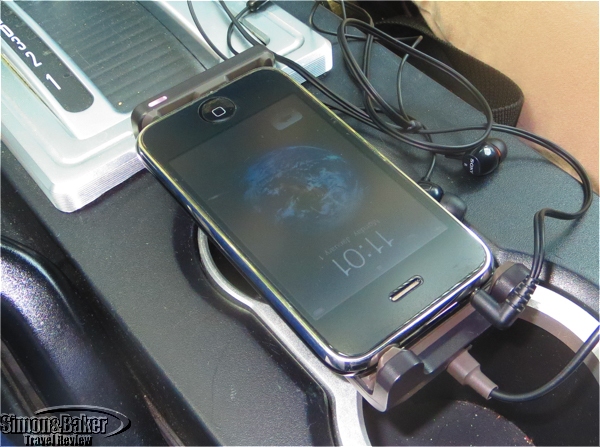
The phone secured in the cradle with the hands free cable attached.
According to the manufacturer, the boosted signal will extend battery life, which makes sense although we did not test it as a specific benefit. More than anything, it was nice to use the phone and maintain a conversation while running our errands or traveling, and reassuring to know that if we had an emergency or car trouble (other than a dead battery), we would be able to make a call even in the former dead zones. We have been satisfied with weBoost Drive Sleek Vehicle Signal Booster Kit and would recommend it to friends looking to increase the mobile phone signal in their cars.
by Editor | Jan 2, 2018 | Luxury Travel

May your New Year be healthy, happy, and prosperous, and offer you rewarding experiences wherever you go!


































